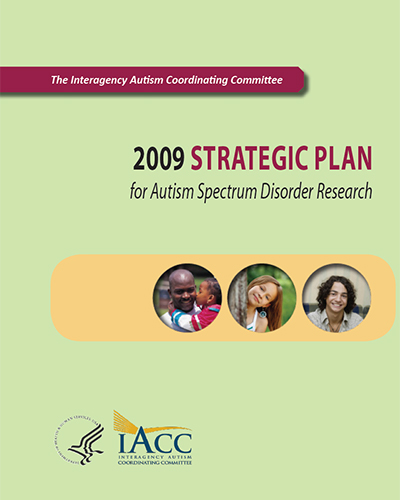IACC Strategic Plan
For Autism Spectrum Disorder Research
2009
- What types of services and supports should I seek and where can I find them?
- What is my state or local government doing to provide services for ASD?
- What is the cost of interventions and how will it be paid?
What do we know?
Discovery of new diagnostic tests and efficacious interventions is necessary but not sufficient to reach the bold vision for this Strategic Plan. To fulfill the mission to "profoundly improve the health and well being of every person on the autism spectrum across the lifespan," scientific discoveries must be implemented in clinical practice and supported by public policy. The gap between knowledge and action can only be overcome by an aggressive focus on engaging families and the services community in the research process, disseminating research findings into the community, eliminating barriers to services and helping people and families identify which services are needed.
The communities in which children are diagnosed vary tremendously in their ability to meet the needs of people with ASD (Shattuck & Grosse, 2007). School districts vary in their ability to identify and provide appropriate educational and related programs for children with ASD (Mandell & Palmer, 2005; Palmer et al., 2005). States vary in the policies they have developed to organize, finance and deliver care to these people. The professional infrastructure or capacity is often inadequate to provide timely diagnosis, appropriate care, and assurance of health and safety.
These differences in policies, resources and organization result in marked differences in the treated prevalence of ASD across geographic areas, the types of services and support that are received, availability of appropriate lifespan transition opportunities, and the associated financial costs to families (Fujiura, Roccoforte, & Braddock, 1994; Ganz, 2007; Järbrink, Fombonne, & Knapp, 2003; Mandell et al., 2008; Ruble et al, 2005; Stahmer & Mandell, 2007). In general, children with ASD have a much more difficult time accessing appropriate care than children with other special healthcare needs (Krauss et al., 2003). Data are still lacking on how these differences in policy and infrastructure relate to the differences in care received, and in turn how these differences affect outcomes for children and families and adults with ASD.
What do we need?
People with ASD and their families need assistance navigating complex service systems. To help address these challenges, a new health services research field of implementation science is emerging to: (a) evaluate the effectiveness of interventions in community settings; (b) identify the most effective means of disseminating research into widespread clinical practice; and, (c) define the best ways for research to inform policy on ASD services and supports. Integral to success will be community engagement in shaping, participating, and disseminating ASD research.
An initial part of this process is the assessment of needs and costs. Care for developmental disorders is financed largely by federal, state and local agencies in both the health care and education sectors. Because there are significant regional differences in ASD resources, describing this varied landscape across states and localities in the U.S. will provide important baseline data for those with ASD and policy makers so they can appropriately seek and plan for services respectively. Research can also define the cost-effectiveness of evidence-based practices and thereby provide the data needed by various payers and policymakers.
In addition to disseminating best practices from ASD treatment and intervention research studies to community settings, so called bench to bedside translation, the other kind of translation, bedside to bench, could take and test promising community practices in rigorously designed research trials. Using a participatory action model, families, people with ASD, and communities can be empowered to become partners in research that can in turn inform policy.
Aspirational Goal: Communities Will Implement High Quality, Evidence-Based And Cost Effective Services And Supports Across The Lifespan For People With ASD
Research Opportunities
- Annual "State of the State" review of policies, services and supports for people with ASD and their families.
- Effective dissemination of evidence-based practices for people with ASD at the community level.
- Cost-effectiveness studies of interventions and services for people with ASD across the lifespan.
- Studies that characterize current ASD diagnostic and service utilization patterns in community settings, examine the relationship between the likelihood of a diagnosis and services availability for ASD, and evaluate services and intervention outcomes.
- Improved and coordinated methods for tracking trends in ASD prevalence across the lifespan of diverse populations.
Short-Term Objectives
- Initiate a "State of the States" assessment of existing state programs and supports for people and families living with ASD by 2009. IACC Recommended Budget: $630,000 over 2 years.
- Support two studies that assess how variations and access to services affect family functioning in diverse populations by 2012. IACC Recommended Budget: $1,000,000 over 3 years.
Long-Term Objectives
- Test the efficacy and cost-effectiveness of at least four evidence-based services for people with ASD of all ages in community settings by 2015. IACC Recommended Budget: $16,700,000 over 5 years.
- Test four methods to improve dissemination of effective interventions in diverse community settings by 2013. IACC Recommended Budget: $7,000,000 over 5 years.




